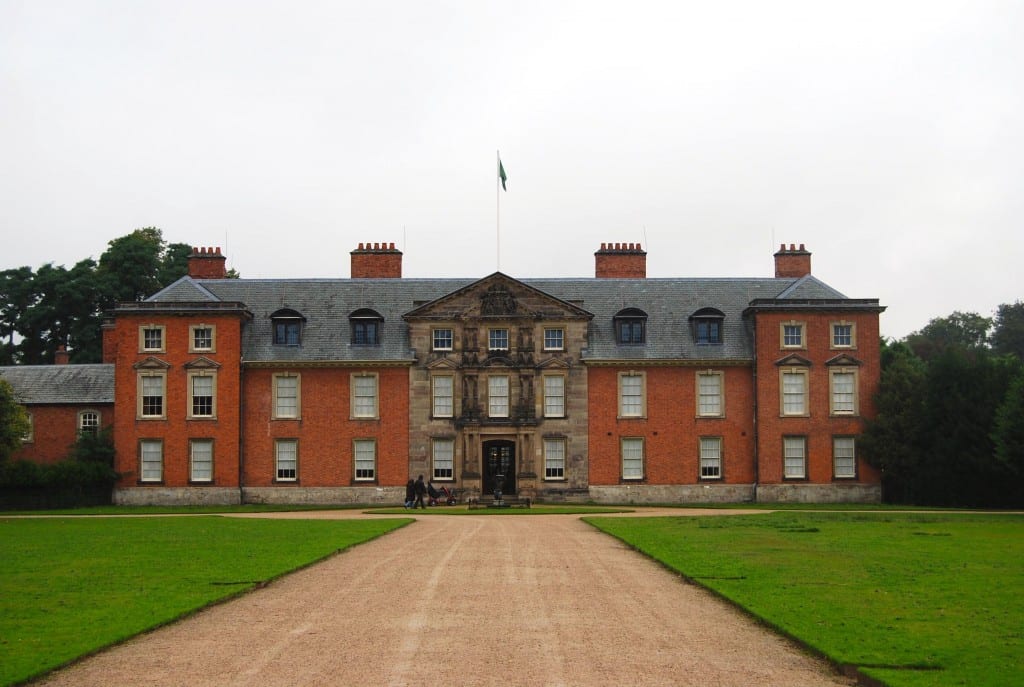Visit to Dunham Massey
After completing preliminary research on Dunham Massey’s ceramic collection, I visited to the house on 10 September 2013. I must admit to a naive longing for the historic site to facilitate the understanding of the wares’ ‘truthful’ role, but it is clear that as the house is subject to modern alterations and reinterpretations steered by the curators in charge, a skewed narrative of past realities is inevitably given. A home is in constant flux, changing with its owners through the centuries. It is therefore essential to acknowledge the limitations of representing only one of these realities to visitors. The ‘historical immersion’ one experiences when visiting the National Trust estate, must be contextualised and understood with its limitations in mind. The current display of Willow Pattern items at Dunham Massey suggests modes of use as well as intended users, but the objects current locations cannot be taken as a representation of the past.
Dunham Massey holds a broad collection of Willow Pattern ware pieces. As noted in the previous section, apart from Standard Pattern wares, the collection also contains a range of variations. The Dunham Massey Willow Pattern collection includes a set of nine breakfast bowls, three chamber pots, three bowls, six saucers, one egg cup, two breakfast cups, eight plates of which one gold rimmed, one wine cooler, one butter dish, one gilt tea pot and one small bowl.
It seems likely that Dunham Massey’s material history was significantly shaped by the family’s involvement in foreign trade, which began with the marriage of George Booth 2nd Earl of Warrington (1675-1758) to Mary Oldbury (unknown-1740) on 9 April 1702. The marriage was spurred by George’s need to clear debts from the family estate. He had inherited Dunham Massey after his father’s death in 1694 and the union to Mary, whose fortune amounted to £24,000, allowed him to settle all financial obligations. Mary Oldbury established the first indirect connection between the East India Company and Dunham Massey, as her father John Oldbury was a merchant who had made a fortune in the East India trade.[1] In 1736, George and Mary’s only daughter Mary (1704-1772) married Harry Grey 4th Earl of Stamford (1715-1768), passing the estate into the Grey family. Almost a century then passed before, with the marriage of Mary Grey (1813-1885) to James Grant Lumsden (1807-63) in 1834, the first direct link between the owners of Dunham Massey and the EIC emerged.[2] James Grant Lumsden was appointed as writer in the EIC, holding various administrative and judicial posts within the Bombay presidency.[3]His brothers Matthew, David, and James, similarly worked within the Company, creating strong connections between the owners of Dunham Massey, their relatives and the EIC. Access to foreign goods and interaction with other international professionals was an important part of the lives of these individuals, though direct personal contacts with China did not occur.
House and Collections manager Katie Taylor, confirms that Willow Pattern wares currently in the collection at Dunham Massey were all acquired by the family and present within the home in 1976, when the Earl of Stamford donated the house to the National Trust. This confirms that the later introduction of these wares by the National Trust can be ruled out. Nevertheless, their presence in the house 1976 tells us little about when they were acquired, by whom and how they were valued and how they were used within the home. To address these issues, I turned to inventories as sources, which could shed further light on the wares, which were housed in this East India Company family home.
[1]The University of Manchester: The John Rylands University Library. ‘Papers of the Lumdsen Family’, GB 133 EGR6.
[2] The University of Manchester: The John Rylands University Library. ‘Papers of the Lumdsen Family’, GB 133 EGR6.
[3] The John Rylands University Library. ‘Grey (Stamford) of Dunham Massey Papers’, GB 133 EGR.
